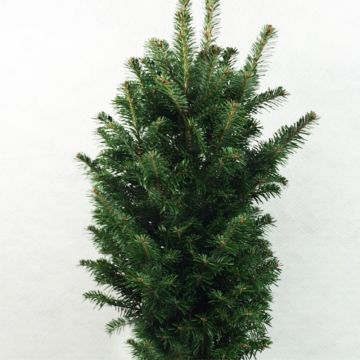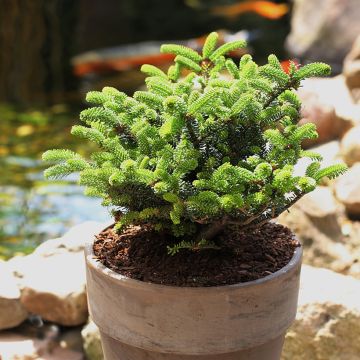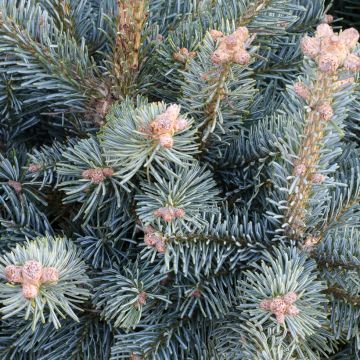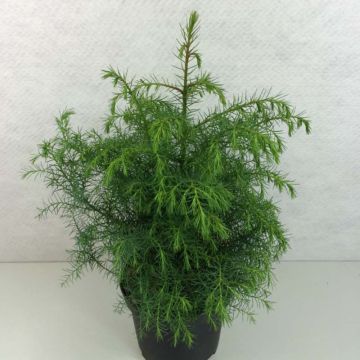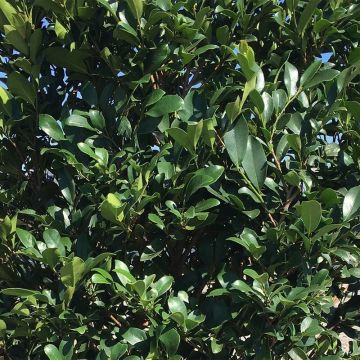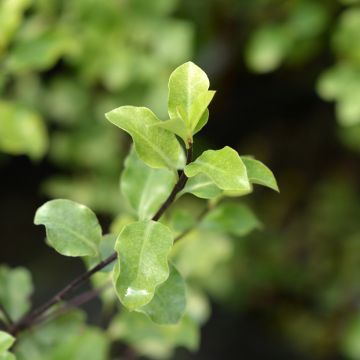

Christmas tree Nordmann Fir - Abies nordmanniana


Christmas tree Nordmann Fir - Abies nordmanniana


Christmas tree Nordmann Fir - Abies nordmanniana


Christmas tree Nordmann Fir - Abies nordmanniana
Christmas tree Nordmann Fir - Abies nordmanniana
Abies nordmanniana
Nordmann Fir, Caucasian Fir
Really a lovely ball well garnished
Laurence P., 15/12/2019
Why not try an alternative variety in stock?
View all →This plant carries a 24 months recovery warranty
More information
We guarantee the quality of our plants for a full growing cycle, and will replace at our expense any plant that fails to recover under normal climatic and planting conditions.
From €5.90 for pickup delivery and €6.90 for home delivery
Express home delivery from €8.90.
Does this plant fit my garden?
Set up your Plantfit profile →
Description
The Abies nordmanniana is the famous Nordmann fir tree that is invited into our homes at Christmas. This tall conifer is appreciated for its perfectly pyramidal habit and its slightly fragrant foliage of dark green needles that resist the dry heat of our homes well. Slow-growing but hardy and resistant, it is also a majestic tree that can be planted in isolation or at the edges of a garden large enough to accommodate it. This beautiful mountain species thrives particularly well in cool and humid climates, in ordinary but deep soil.
The Abies nordmanniana, sometimes also called Caucasian fir or Crimean fir, is a conifer of the pinaceae family native to the temperate regions of Western Asia: Georgia, Russia, Armenia, to the south of the Black Sea in Turkey and Crimea. It grows in mountain forests, under a rather humid continental climate, even though it temporarily tolerates drought. In nature, this species with a regular pyramidal habit can reach up to 60m (197ft) in height, and forms a trunk that can measure up to 2m (6.6ft) in diameter. It was introduced to Europe around 1848.
In our gardens, it can still reach 30m (98.4ft) in height and 6-7m (19.7 - 23ft) in width after many years, so its future development should be taken into account at the time of purchase. This tree has a short, straight trunk and widely spread lower branches. Its growth is very slow. Its flat needle-shaped leaves, 2 to 3.5cm (1.2in) long and 2mm (0.1in) wide, are very dark green and shiny, marked by two light bands on the underside. Truncated at their ends, they are tactile and give off a very pleasant aroma when crushed, reminiscent of oranges. The branches have a rounded shape, due to the radiating and very dense arrangement of the needles. The grey-brown bark is smooth, sometimes wrinkled on mature subjects. The fruits are cylindrical cones, reddish-brown in colour, 10 to 20cm (7.9in) long and 4 to 5cm (2in) wide. They are upright and scaly, and release winged seeds that will be dispersed by the wind when ripe. This Abies is quite sensitive to urban pollution and does not tolerate salt spray.
The Abies nordmanniana is the traditional Christmas tree, often chosen to decorate the house during the end-of-year holidays. Once this festive period is over, the conscientious gardener who has done his best to preserve it, will plant it in the ground. With its perfect silhouette, strong presence, resistance, and ease of cultivation, it will be wonderful as an isolated specimen or at the edge of a large garden.
Report an error about the product description
Christmas tree Nordmann Fir - Abies nordmanniana in pictures


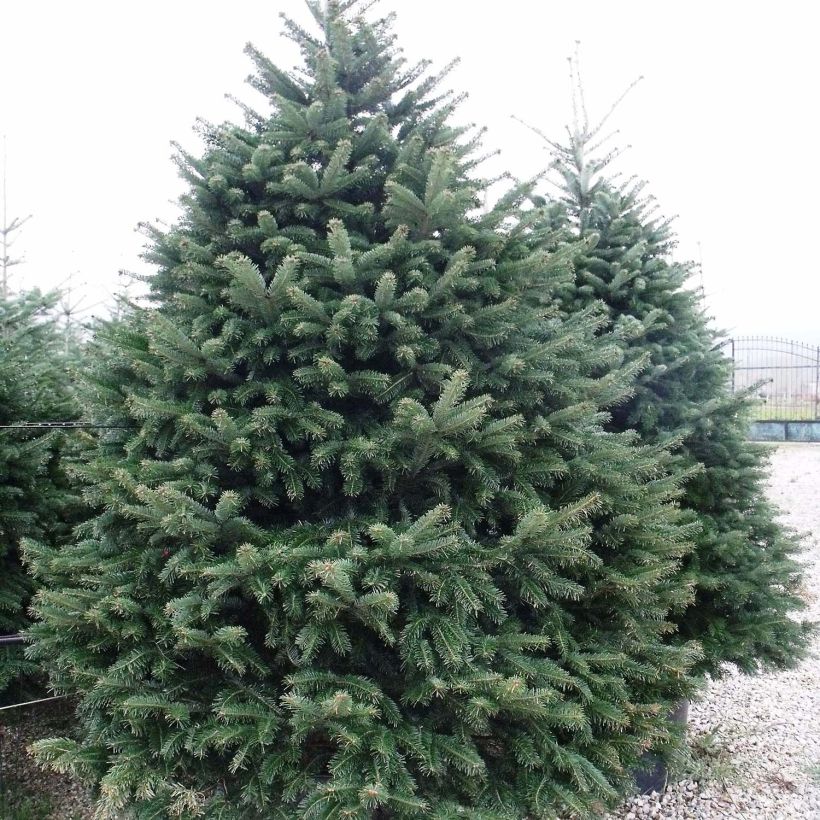

Plant habit
Foliage
Botanical data
Abies
nordmanniana
Pinaceae
Nordmann Fir, Caucasian Fir
Caucasus
Other Abies
Planting and care
The Abies nordmanniana is best planted in spring or autumn, in a deep soil that retains some moisture, rich in humus, slightly acidic, neutral or slightly chalky. It also appreciates fertile soils, rich in clay. This tall conifer thrives in non-scorching sun or partial shade. Regularly water the young plants during the months following planting and weed the soil in summer. The Nordmann fir tolerates occasional periods of drought, it is a fairly adaptable and very hardy species. However, it is not suitable for very dry and hot regions. This tree does not require pruning, but dead or crossing branches can be removed.
Planting period
Intended location
Care
-
, onOrder confirmed
Reply from on Promesse de fleurs
Evergreen shrubs
Haven't found what you were looking for?
Hardiness is the lowest winter temperature a plant can endure without suffering serious damage or even dying. However, hardiness is affected by location (a sheltered area, such as a patio), protection (winter cover) and soil type (hardiness is improved by well-drained soil).

Photo Sharing Terms & Conditions
In order to encourage gardeners to interact and share their experiences, Promesse de fleurs offers various media enabling content to be uploaded onto its Site - in particular via the ‘Photo sharing’ module.
The User agrees to refrain from:
- Posting any content that is illegal, prejudicial, insulting, racist, inciteful to hatred, revisionist, contrary to public decency, that infringes on privacy or on the privacy rights of third parties, in particular the publicity rights of persons and goods, intellectual property rights, or the right to privacy.
- Submitting content on behalf of a third party;
- Impersonate the identity of a third party and/or publish any personal information about a third party;
In general, the User undertakes to refrain from any unethical behaviour.
All Content (in particular text, comments, files, images, photos, videos, creative works, etc.), which may be subject to property or intellectual property rights, image or other private rights, shall remain the property of the User, subject to the limited rights granted by the terms of the licence granted by Promesse de fleurs as stated below. Users are at liberty to publish or not to publish such Content on the Site, notably via the ‘Photo Sharing’ facility, and accept that this Content shall be made public and freely accessible, notably on the Internet.
Users further acknowledge, undertake to have ,and guarantee that they hold all necessary rights and permissions to publish such material on the Site, in particular with regard to the legislation in force pertaining to any privacy, property, intellectual property, image, or contractual rights, or rights of any other nature. By publishing such Content on the Site, Users acknowledge accepting full liability as publishers of the Content within the meaning of the law, and grant Promesse de fleurs, free of charge, an inclusive, worldwide licence for the said Content for the entire duration of its publication, including all reproduction, representation, up/downloading, displaying, performing, transmission, and storage rights.
Users also grant permission for their name to be linked to the Content and accept that this link may not always be made available.
By engaging in posting material, Users consent to their Content becoming automatically accessible on the Internet, in particular on other sites and/or blogs and/or web pages of the Promesse de fleurs site, including in particular social pages and the Promesse de fleurs catalogue.
Users may secure the removal of entrusted content free of charge by issuing a simple request via our contact form.
The flowering period indicated on our website applies to countries and regions located in USDA zone 8 (France, the United Kingdom, Ireland, the Netherlands, etc.)
It will vary according to where you live:
- In zones 9 to 10 (Italy, Spain, Greece, etc.), flowering will occur about 2 to 4 weeks earlier.
- In zones 6 to 7 (Germany, Poland, Slovenia, and lower mountainous regions), flowering will be delayed by 2 to 3 weeks.
- In zone 5 (Central Europe, Scandinavia), blooming will be delayed by 3 to 5 weeks.
In temperate climates, pruning of spring-flowering shrubs (forsythia, spireas, etc.) should be done just after flowering.
Pruning of summer-flowering shrubs (Indian Lilac, Perovskia, etc.) can be done in winter or spring.
In cold regions as well as with frost-sensitive plants, avoid pruning too early when severe frosts may still occur.
The planting period indicated on our website applies to countries and regions located in USDA zone 8 (France, United Kingdom, Ireland, Netherlands).
It will vary according to where you live:
- In Mediterranean zones (Marseille, Madrid, Milan, etc.), autumn and winter are the best planting periods.
- In continental zones (Strasbourg, Munich, Vienna, etc.), delay planting by 2 to 3 weeks in spring and bring it forward by 2 to 4 weeks in autumn.
- In mountainous regions (the Alps, Pyrenees, Carpathians, etc.), it is best to plant in late spring (May-June) or late summer (August-September).
The harvesting period indicated on our website applies to countries and regions in USDA zone 8 (France, England, Ireland, the Netherlands).
In colder areas (Scandinavia, Poland, Austria...) fruit and vegetable harvests are likely to be delayed by 3-4 weeks.
In warmer areas (Italy, Spain, Greece, etc.), harvesting will probably take place earlier, depending on weather conditions.
The sowing periods indicated on our website apply to countries and regions within USDA Zone 8 (France, UK, Ireland, Netherlands).
In colder areas (Scandinavia, Poland, Austria...), delay any outdoor sowing by 3-4 weeks, or sow under glass.
In warmer climes (Italy, Spain, Greece, etc.), bring outdoor sowing forward by a few weeks.




































